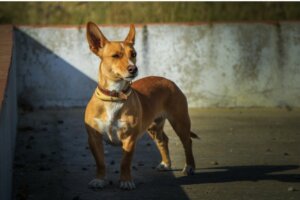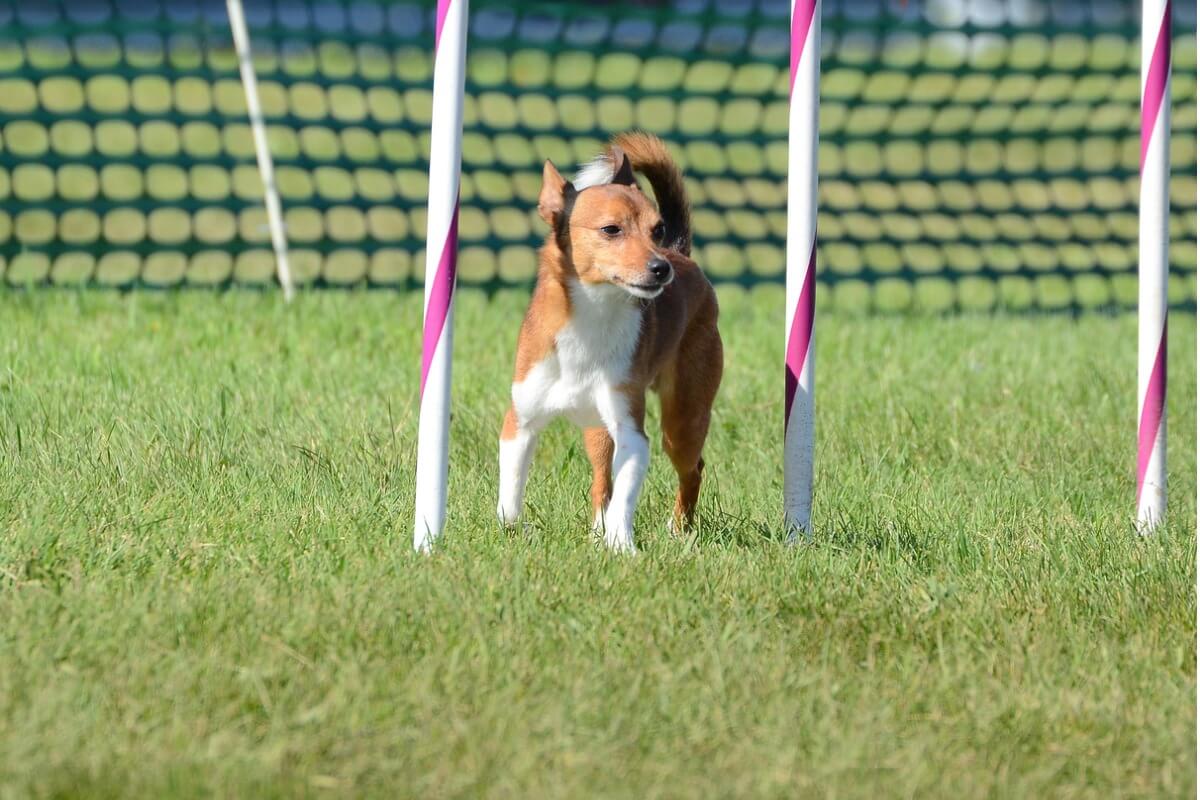The Portuguese Podengo: Characteristics and Care

The Portuguese Podengo (also called the Portuguese Warren Hound) is one of the most commonly seen dogs in the country that gives it its name, as well as in the rest of the Iberian Peninsula. They’re very expressive animals with a strong personality, and become very dear pets in the family home.
If you want to know a little more about this striking breed, here’s all you need to know about their characteristics, care and health. Don’t miss it, because we’re sure that by the end of this article, you’ll have fallen in love with the Portuguese Podengo.
Characteristics of the breed
There are different types of Portuguese Podengo depending on their size. In this article, we’ll talk about the small version, which measures about 20-30 centimeters (8-12 inches) to the withers and weighs between 4 and 6 kilograms (9 to 13 pounds). Even with its small size, it’s quite muscular with strong legs.
Its head has pronounced angles with a sharp, pyramid-shaped muzzle. The ears are erect and with rounded tips, although triangular. The tail, on the other hand, is usually erect and sickle-shaped.
There are two varieties of the Portuguese Podengo in terms of its coat. One of them is short-haired, which is soft and smooth, and the other is the long-haired, harder, less populated, and bearded. This dog has only one coat. The Fédération Cynologique Internationale (FCI) accepts the following colors for him: black, brown, white or spotted of these 3 shades.

Origin of the small Portuguese Podengo
It’s a very old breed of dog, classified within the group of primitive dogs and spitz. It’s estimated that their first ancestors arrived in the Iberian Peninsula transported by the Phoenicians, back in 700 BC. During this period it’s believed that they crossed with the continental wild dogs.
Subsequently, these ancestors were crossed with dogs brought by the Arabs during the eighth century. At this time, the artificial selection of the ancient small Portuguese Podengo began to make it suitable for hunting.
The small Portuguese Podengo that we know today began to take shape in the middle of the 15th century, when specimens accompanied navigators on their ships to control rodent populations. Currently, it’s considered one of the national breeds of this country.
The character of the small Portuguese Podengo
This dog has very well-developed senses, as it was bred to be able to detect the prey of hunters. In addition to this, it’s a dog with a high level of activity and a good attentional capacity.
The small Portuguese Podengos tend to be independent, although this doesn’t mean that they don’t have a close bond with their owners or don’t enjoy their affection. Simply put, it doesn’t give great signs of affection and you should respect their periods of rest and solitude.
As well as being an active dog, it’s also intelligent and wily, although stubborn and somewhat overprotective with their personal space. They’re very versatile canids in training and learn quickly, but require extra effort and patience to help them carry out correct emotional management and socialization.
Care needs
By not having an inner layer of fur, their coat is easy to care for. However, it requires some weekly brushing to avoid tangles, especially in the long-haired varieties. Also, it isn’t advisable to bathe them very often (except in the case of accidents), as its skin is more exposed than in other breeds and it could lose the oily layer that protects it.
Its training requires special attention due to his high level of activity and intelligence. They are canines that benefit from constancy by underlining the marked limits and socialization from an early age so that they are able to relate without falling into territoriality and overprotection of their guardians.
In addition, they require long walks that include enrichment and sport. Agility or canicross are good options for him and for you, as they discharge large amounts of energy and you can spend quality time together.
It’s also necessary to clarify that, even though it’s an independent dog, this doesn’t mean that the Portuguese Podengo can stay alone for long periods of time. It needs the same love as any other dog and an enriched environment at home.
The health of the small Portuguese Podengo
Although pure breeds tend to carry certain congenital problems due to selected crosses, the small Portuguese Podengo is in very good health. Of course, they’re prone to skin diseases, such as allergies and dermatitis.
Most of the problems to which these animals are predisposed are easily prevented with proper care in terms of food, psychological needs, and hygiene. In addition, don’t forget to keep your vaccination schedule, deworming, and check-ups up to date.
In short, this dog is ideal for those who live in an apartment and have resources when it comes to giving it good training. It may not be a dog that curls up next to you on the couch (although don’t forget that each one has its own personality), but the bond you create with them will be as strong as with any other dog.
The Portuguese Podengo (also called the Portuguese Warren Hound) is one of the most commonly seen dogs in the country that gives it its name, as well as in the rest of the Iberian Peninsula. They’re very expressive animals with a strong personality, and become very dear pets in the family home.
If you want to know a little more about this striking breed, here’s all you need to know about their characteristics, care and health. Don’t miss it, because we’re sure that by the end of this article, you’ll have fallen in love with the Portuguese Podengo.
Characteristics of the breed
There are different types of Portuguese Podengo depending on their size. In this article, we’ll talk about the small version, which measures about 20-30 centimeters (8-12 inches) to the withers and weighs between 4 and 6 kilograms (9 to 13 pounds). Even with its small size, it’s quite muscular with strong legs.
Its head has pronounced angles with a sharp, pyramid-shaped muzzle. The ears are erect and with rounded tips, although triangular. The tail, on the other hand, is usually erect and sickle-shaped.
There are two varieties of the Portuguese Podengo in terms of its coat. One of them is short-haired, which is soft and smooth, and the other is the long-haired, harder, less populated, and bearded. This dog has only one coat. The Fédération Cynologique Internationale (FCI) accepts the following colors for him: black, brown, white or spotted of these 3 shades.

Origin of the small Portuguese Podengo
It’s a very old breed of dog, classified within the group of primitive dogs and spitz. It’s estimated that their first ancestors arrived in the Iberian Peninsula transported by the Phoenicians, back in 700 BC. During this period it’s believed that they crossed with the continental wild dogs.
Subsequently, these ancestors were crossed with dogs brought by the Arabs during the eighth century. At this time, the artificial selection of the ancient small Portuguese Podengo began to make it suitable for hunting.
The small Portuguese Podengo that we know today began to take shape in the middle of the 15th century, when specimens accompanied navigators on their ships to control rodent populations. Currently, it’s considered one of the national breeds of this country.
The character of the small Portuguese Podengo
This dog has very well-developed senses, as it was bred to be able to detect the prey of hunters. In addition to this, it’s a dog with a high level of activity and a good attentional capacity.
The small Portuguese Podengos tend to be independent, although this doesn’t mean that they don’t have a close bond with their owners or don’t enjoy their affection. Simply put, it doesn’t give great signs of affection and you should respect their periods of rest and solitude.
As well as being an active dog, it’s also intelligent and wily, although stubborn and somewhat overprotective with their personal space. They’re very versatile canids in training and learn quickly, but require extra effort and patience to help them carry out correct emotional management and socialization.
Care needs
By not having an inner layer of fur, their coat is easy to care for. However, it requires some weekly brushing to avoid tangles, especially in the long-haired varieties. Also, it isn’t advisable to bathe them very often (except in the case of accidents), as its skin is more exposed than in other breeds and it could lose the oily layer that protects it.
Its training requires special attention due to his high level of activity and intelligence. They are canines that benefit from constancy by underlining the marked limits and socialization from an early age so that they are able to relate without falling into territoriality and overprotection of their guardians.
In addition, they require long walks that include enrichment and sport. Agility or canicross are good options for him and for you, as they discharge large amounts of energy and you can spend quality time together.
It’s also necessary to clarify that, even though it’s an independent dog, this doesn’t mean that the Portuguese Podengo can stay alone for long periods of time. It needs the same love as any other dog and an enriched environment at home.
The health of the small Portuguese Podengo
Although pure breeds tend to carry certain congenital problems due to selected crosses, the small Portuguese Podengo is in very good health. Of course, they’re prone to skin diseases, such as allergies and dermatitis.
Most of the problems to which these animals are predisposed are easily prevented with proper care in terms of food, psychological needs, and hygiene. In addition, don’t forget to keep your vaccination schedule, deworming, and check-ups up to date.
In short, this dog is ideal for those who live in an apartment and have resources when it comes to giving it good training. It may not be a dog that curls up next to you on the couch (although don’t forget that each one has its own personality), but the bond you create with them will be as strong as with any other dog.
All cited sources were thoroughly reviewed by our team to ensure their quality, reliability, currency, and validity. The bibliography of this article was considered reliable and of academic or scientific accuracy.
- FCI. (30.03.2009). PODENCO PORTUGUÉS (Podengo português) . 30.07.2019, de FEDERATION CYNOLOGIQUE INTERNATIONALE Sitio web: http://www.fci.be/Nomenclature/Standards/094g05-es.pdf
- Gomes, M. L. S. C. (2003). Raças caninas autóctones portuguesas–Contributo para o seu estudo genético e demográfico.
This text is provided for informational purposes only and does not replace consultation with a professional. If in doubt, consult your specialist.








